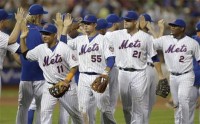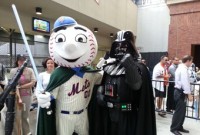Wilmer Flores
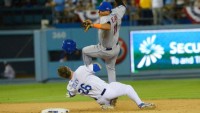
Next year, Chase Utley is going to be a utility player. He going to be a utility player because he’s 37 years old, and he has diminishing skills. He could retire, but he decided to hang around for another year or two. He’s not in this situation because someone injured him.
Last year, Ruben Tejada was not the starting shortstop on the Opening Day roster for the first time in his career. No, last year, the job was given to Wilmer Flores. Tejada was going to be a utility player to start the season. Then something strange happened. For all the years of the Mets just handing him the job, and him failing to hold onto it, Tejada finally rose to the challenge the year the job wasn’t just handed to him.
Last year, Flores had his offensive and defensive struggles. The Mets team was decimated by injuries. Tejada got some regular playing time. He then got some time at shortstop. He showed that while he had less range than Tejada, he had a steadier hand. More importantly, he began to hit:
- July .287/.330/.347
- August .235/.381/.294
- September .297/.357/.406
He entered the postseason as the Mets starting shortstop over Flores. He earned that right. Then with one dirty play Chase Utley took it all away. Tejada broke his leg. In the offseason, while he was hobbling around with a walking boot, the Mets signed Asdrubal Cabrera to take his place.
Utley reportedly reached out to David Wright to apologize to Tejada. He reportedly sent Tejada some things in the offseason. For his part, Tejada says all he wants is an apology.
Up until now, Utley has gone on and on about how he was playing hard and that he was playing the right way. However, his actions at least show remorse. The reason for this is he broke an unwritten rule, perhaps the most important rule amongst all players in all sports. You don’t injure other players with dirty, or even borderline plays. You don’t ruin another player’s career. Utley did that.
Utley took away Tejada’s job with one dirty play. Like Utley, Tejada is now a utility player. For what it’s worth, Tejada is not letting this hold him back:
I’m going to keep working hard, you never know what’s going to happen here. I want to stay focused all the time.
In 2015, Tejada was a utility player to start the season, and he finished the year as the starting shortstop. Utley put him back in that position this year. I’m not counting out Tejada this year, especially with dirty players like Utley out there.
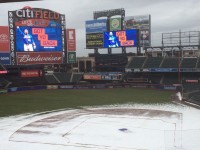
Am I the only one that finds it incredibly fitting that Yoenis Cespedes is being introduced during a rainy day? Remember, it might’ve been a rainy day that brought him here in the first place.
Roughly half a year ago, there was some hope in the Mets season. The team had just acquired Tyler Clippard, Kelly Johnson, and Juan Uribe. Michael Conforto was up with the team and producing well ahead of schedule. Travis d’Arnaud was soon to return. While Mets fans had seen some bad baseball for far too long, things were seemingly getting much better. Then disaster struck.
There was the inexplicable drama surrounding the failed Carlos Gomez trade. Wilmer Flores was left standing on the field crying. Then we discover the trade didn’t happen. The Mets say Gomez failed a physical. The Brewers said the Mets wanted money in the deal. With all that hovering, the Mets took the field for a rainy day game. They had a 7-1 lead going into the seventh, and a 7-5 lead heading into the ninth. The Padres had two outs and Jeurys Familia had an 0-2 count on Derek Norris.
The heavens opened causing the umps to call a rain delay for a game that could’ve ended with one more pitch. The delay nearly lasted an hour. When they game resumed Familia allowed a single to Norris, another single to Matt Kemp, and then a three run homer to one-time trade target Justin Upton. After another rain delay of around two and a half hours, the game resumed seeing the Mets go down meekly 1-2-3 in the ninth. Whatever good feelings and momentum in the season was there, it was seemingly washed away. The fans were angry.
The rains eventually cleared. There would be a new day both literally and metaphorically when the Mets pulled the trigger on the trade for Yoenis Cespedes. Sure the Mets win the NL East without him, but man, the 2015 season had a different feel to it when he came on board. It was a fun run, and now he’s back. We’re ready for another ride.
But first, he’s going to be re-introduced to the fans on a rainy day. Seeing how it was a rainy day that brought him here, I wouldn’t have it any other way.
Welcome back Cespedes.

While everyone is trying to decipher the outfield configuration after the Yoenis Cespedes signing, there is the issue of how the signing puts added importance on Wilmer Flores‘ ability to be a backup infielder.
Third Base
Make no mistake. The Mets need Flores to be able to handle the role and handle it well. For starters, we do not know David Wright‘s ability to withstand a full 162 game schedule. Last year, Wright had difficulty playing three days in a row. It impacted his offense and defense. With a full offseason to continue the extra work needed due to his spinal stenosis, that could change for Wright. It also may be a new reality.
Flores has to be ready, willing, and able to play third at a monent’s notice. In his major league career, Flores has only played 209 innings at third base. During that limited time, he did show the ability to handle the position. The problem is he has to work on his third base defense while addressing his second base defense.
Second Base
When the Mets acquired Neil Walker to replace Daniel Murphy, the Mets obtained a switch-hitting second baseman who has hit .272/.338/.427 over the course of his career. That’s with him coming off the worst year of his career last year when he hit .269/.328/.427 with 16 homers and 71 RBI. One of Walker’s issues last year was left-handed pitching. Walker hit a dreadful .237/.284/.290 in 62 games against lefties. For his career, Walker has hit an underwhelming .260/.317/.338 against lefties in his career. Effectively, Walker is a platoon player.
Ideally, that platoon parter would be Flores. However, Flores has to be able to hit lefties himself. Last year, Flores did that with aplomb. In 57 games, Flores hit .310/.355/.600 with 7 of his 16 homers against lefties last year. However, for his career, Flores has only hit .230/.288/.403 against lefties in his brief major league career. Overall, for the Walker trade to work Flores needs to be the 2015 version of himself against lefties as opposed to what he’s done against them in his entire career.
First Base
First base is where it starts to get dicey for Flores. With the Cespedes signing, Lucas Duda became the only player on the roster with any major league experience at first base. This forces Flores to learn a new position in addition to keeping prepared for his other backup roles.
How much Flores is needed will depend on Duda. Last year, Duda hit a respectable .285/.333/.545 with seven homers and 21 RBI in 82 games. However, much of that was fueled by an extraordinarily high BABIP of .385. For his career, Duda has hit .229/.301/.369 with a .321 BABIP. In short, Duda is due for a regression against lefties. It will be Flores’ job to cushion the fall back to earth while hoping his numbers against lefties doesn’t regress either.
Shortstop
The Mets signed Asdrubal Cabrera to be the new everyday shortstop. A role that used to belong to Flores. Cabrera’s backup to open the season should be Ruben Tejada, who actually wrestled the shortstop job away from Flores last year.
Here’s the issue. The one spot Flores isn’t backing up is the one spot he’s most needed. Last year, Cabrera had a -6.0 UZR and a -7 DRS at shortstop. For his career, he has a -55.5 UZR and a -29 DRS at short. Tejada had a -5.6 UZR and a -15 DRS at short last year. For his career, he has a -1.5 UZR and a -20 DRS there. Flores had a -2.5 UZR and a -10 DRS at short last year with a 1.5 UZR and a -13 DRS for his career.
So defensively, Flores is the best shortstop option. However, the Mets are going with Cabrera in the hopes that his .328/.372/.544 second half will carry forward because otherwise the Mets signed a shortstop who has hit .249/.307/.405 in the three years since his last All Star appearance. Ironically, the position Flores is best suited to on this team is not a position he is tops on the depth chart going into next season.
Pinch Hitter
Since this is the National League, Flores will need to be ready to pinch hit for the pitcher or for a left handed when a LOOGY enters the game. In his career, Flores has only had 13 plate appearances where he hit .250/.308/.333. These are around his career numbers of .253/.287/.386. Accordingly, Flores can reasonably be expected to replicate his career batting line as a pinch hitter next year. Whether that’s good or not is a whole other matter.
Conclusion
Surprisingly, much of what the Mets want to do lies on Flores’ shoulders. He had to platoon at second. He had to hit against tough left-handles while playing first. He has to be available at a moment’s notice to play third. He’s available to play each and every one of these roles because the Mets are placing their top shortstop option, Flores, on the bench.
Flores is still only 24 years old. He works hard, and he will do everything he can do to improve and help the team. He’s going to need to be proficient in three to four infield positions because the Mets really need his help.
Editor’s Note: this article first appeared on metsmerized.com
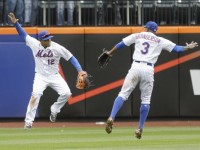
Fans are clamoring for Yoenis Cespedes. They want him. They need him. Here’s the problem. What’s the corresponding move?
When the Cubs signed Ben Zobrist, they were prepared. They had a deal worked out for Starlin Castro to go to the Yankees. Having the deal in place helped prevent the market from suppressing Castro’s value because the Cubs would’ve had to trade Castro. If the Mets want to sign Cespedes, they’re going to have to do the same thing.
Right now, the Mets have Michael Conforto in left, Juan Lagares and Alejandro De Aza platooning in center, and Curtis Granderson in right. If you sign Cespedes, something’s gotta give. Let’s start with the obvious. You’re not moving Conforto. Also, with the Mets signing De Aza cannot be traded until June 15th. That leaves Granderson and Lagares. Which one do you move? It’s a matter of selling low on Lagares or selling high on Granderson.
If you trade Lagares, you’re trading an elite defensive player. He was a 5.5 WAR player and a Gold Glover just in 2014. He had a down year in 2015. We don’t know how much of it had to do with his elbow injury, but he fell off the map defensively. He went from an 18.6 UZR to a 3.5. Basically, he went from a Gold Glover to merely above average. If Lagares isn’t elite defensively, he’s not an everyday player.
I still think Lagares has value. He had a terrific postseason hitting .348/.375/.435. He performed well in Winter League action this, even if he showed platoon splits. He’s still just 26 years old. The hope is he rebuilds his value. If he does, and you sell low, you’re going to regret it.
The other choice is Granderson, who may be at the apex of his value. Last year he hit .259/.364/.457. He was a dynamic leadoff hitter. For long stretches of the season, he was the only legitimate hitter in the lineup holding things together. He was a Gold Glove finalist. He was the best position player on the Mets last year. He then followed it up with a great postseason. He hit three World Series homeruns. He’s a great fit for a win-now team like the Mets.
However, he is turning 35 before the start of the next season. He’s a year removed from a .237/.326/.388 season. He just had surgery on a torn ligament in his thumb. There are risks relying upon his production for next year.
The last option would be to keep everyone. That is a monumental task for Terry Collins. You have to keep Lagares and De Aza happy with even more limited at bats. You have to hold off on the temptation of benching Conforto for stretches if he struggles or goes into a prolonged slump. There’s an issue of relying on Wilmer Flores too much. Remember, he hit .263/.295/.408 last year. The Mets still need a 1B/OF option.
Putting aside the issues it would create, Cespedes is a good player who could help the Mets. The fans want him. The issue then becomes who do the fans want to jettison?
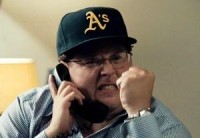
From what I gather from reading incorrect interpretations of the book, I take many people did not actually read Moneyball. If you haven’t, you should go and read it. If you have, now is the time to re-read it.
The reason to re-read it now is the script for the Mets postseason lies within those pages. I know Sandy Alderson was no longer the A’s GM at the time; it was Billy Beane. However, remember Beane’s top two lieutenants were J.P. Riccardi and Paul DePodesta. Until recently, they were Alderson’s top lieutenants. They were at least in place when the Mets were creating their offseason plans.
One of the many aspects of the book, which the movie seemed to get purposefully wrong, was how the A’s went about replacing Jason Giambi and one-year rental Johnny Damon. In essence, the A’s determined they flat out didn’t have enough money to replace these guys with other high priced players. Instead, the A’s were going to have to replace their production using a different line of thinking. I’m summing up here and being a little over simplistic, but here was the thought process:
- The team needed to identify what was undervalued on the free agent market (OBP);
- They needed the cumulation of their entire roster to replace Giambi and Damon since they couldn’t just sign two big name free agents to do it; and
- They needed to do it as cheaply as possible.
So what did they do? Well we know the Scott Hatteberg story with him being moved to first due to his traditionally high OBP (more on that later). In the movie and most other places, the story behind the David Justice acquisition is plain wrong. The A’s obtained him from the Mets, not the Yankees, in exchange for a LOOGY by the name of Mark Guthrie and a mistake waiting to happen by the name of Tyler Yates. It was the Mets, not the Yankees, who kicked in salary. It was only $1.2 million.
Now for the moves that haven’t received much fanfare. The A’s handed the secondbase job to a young Mark Ellis, who was capable of higher production than last year’s second baseman Frank Menechino. Menechino was moved to the bench to create a deeper roster. The A’s traded for Carlos Pena, who was a promising young player. Pena was supposed to be the first baseman with Hatteberg at DH and Justice in LF. That’s the way it was up until the trade deadline. They also traded for Billy Koch to sure up the closer’s role for the departed Jason Isringhausen.
By design, the A’s replaced Giambi and Damon not only with Pena and Justice, but by also improving their DH spot (Olmedo Saenz and Jeremy Giambi) and secondbase. In essence, the A’s added three new starters putting their old starters on the bench. The A’s left some payroll flexibility and had assets for the trade deadline.
The A’s used Pena in a three way trade to acquire Ted Lilly to sure up the rotation behind their three young big pitchers. They then used a prospect to acquire Ray Durham to DH with some needed cash. Hatteberg moved to be the full time first baseman. And yes, like in the movie, the A’s also added Ricardo Rincon to be the LOOGY to sure up the bullpen.
Did it work? If you look at the record, it absolutely did. They went from a 102 win team to a 103 win team. However, the reason wasn’t Hatteberg or Rincon. No, the part we forget is Barry Zito won the Cy Young, and Miguel Tejada win the MVP. They were powered by an insane 20 game winning streak. Lost in that streak was the A’s played only one team over .500 and played two teams that lost over 100 games that year.
The 2002 A’s got top notch performances from their top guys, and they made sure to beat the teams they were supposed to beat. Make no mistake. The 2002 A’s were worse. They scored 84 less runs and allowed nine more runs. However, at the end of the day, it didn’t matter. They won one more game.
The Mets are in a similar position as the A’s were. Make no mistake about it, the Mets have limited funds. With those funds, they needed to go out and replace the production of Daniel Murphy and a half a season of Yoenis Cespedes. Last year, Murphy hit .281/.322/.449 with 14 homers and 73 RBI. Cespedes hit .287/.337/.604 with 17 homers and 44 RBI in his time with the Mets.
We already know how the Mets replaced that production. They traded for Neil Walker, who hit .269/.328/.427 with 16 homers and 71 RBI. He’s a career .272/.338/.431 hitter. The Mets then decided to go with a platoon in center. There is in-house option Juan Lagares to hit against lefties. He hit .273/.333/.438 against lefties last year and .279/.325/.427 for his career. Platooning with him is Alejandro De Aza, who hit .278/.351/.448 against righties last year and .274/.338/.418 for his career. Now, this isn’t enough to replace the production of both of Murphy and Cespedes.
That’s where Asdrubal Cabrera comes in. Last year, Wilmer Flores played the bulk of time at shortstop hitting .263/.295/.408. Ruben Tejada played a lot there hitting .261/.338/.350. The Mets hoped by signing Cabrera they have significantly upgraded the position to cover the loss of Murphy and Cespedes. Cabrera hit .265/.315/.430 last year with the Rays. Speaking of replacing Cespedes’ second half production Cabrera hit .328/.372/.544 in the second half last year. Tangentially, the bench is theoretically better by having Flores and Tejada there.
Following the script they invented in Oakland, the Mets have already done what they believe they needed to do to replace the production they have lost. Right now, the Mets projected payroll is ~$106 million or about $4 million less than the 2015 payroll. Accordingly, the Mets are maintaining payroll flexibility like the A’s did so they can make trades at the deadline.
And, by the way, the Mets are powered by their three big young starters. How will it work out in 2016? We don’t know yet. However, if history is any lesson, the 2016 Mets will be worse than the 2015 version. If they want to have a better record, the 2016 Mets will need to take advantage of their games against bad teams like the Phillies and Braves. One of the young pitchers will have to step up even more. We’ll see which everyday player can step up to have the Tejada-like season.
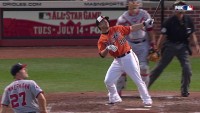
It seems like long ago the Mets decided they didn’t want the expensive top end talent for 2016. They are actively seeking a deeper 25 man roster over a more talented starting nine. To that end, the Mets have interest in Steve Pearce.
Pearce is a career .246/.325/.431 right handed hitter. He has a career OPS+ of 105. He had a great 2014 hitting .293/.373/.556 with 21 homers, 49 RBI, and an OPS+ of 157 in 102 games. Last year, he had a steep drop off. He hit .218/.289/.422 with 15 homers, 40 RBI, and a 91 OPS+ in 92 games. Overall, this tells us he’s a bench player. You really never know what you’re going to get year to year. He has the potential to be really good and really bad. The question is if he can help the Mets.
The 2014 version can. The 2015 version was no better than Eric Campbell. On average, he’s a useful player. He’s an adequate 1B/OF. To that end, he could replace Michael Cuddyer‘s expected production, even if he won’t replace his clubhouse presence. If the Mets do obtain Pearce, it should be as an occasional started against tough lefties instead of being your prototypical National League bench player.
For his career, Pearce hits .238/.314/.400 against righties and .262/.343/.481 against lefties. With platoon splits like these, he is a good candidate to take at bats against tough lefties in place of Curtis Granderson or Michael Conforto. Just don’t ask him to pinch hit. As a pinch hitter, Pearce hits .170/.255/.284. Yes, 98 plate appearances is a small sample size, but those numbers are just bad no matter how you slice and dice it. Signing him fills out the roster almost completely. It also makes Wilmer Flores that top right handed pinch hitter. That’ll be hard with the Mets having him play everywhere next season.
Overall, Pearce could help the Mets. He may not be an exciting move, but then again depth moves rarely are. To that end, signing him would be the perfect end to the offseason.
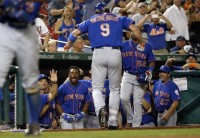
There are always players we like more than others. Putting aside Obviously Mets, I liked Kirk Nieuwenhuis more than your average fan.
Every year, my brother and I have the same argument. I think of Nieuwenhuis as a useful player. He’s a solid defender at three outfield positions. He is a platoon player/fourth outfielder. His problem has always been the fact that he’s overexposed by a poor Mets team needing to play him more frequently than he should.
Most Mets fans were like my brother. They saw a guy with admittedly underwhelming statistics. At times, Kirk was one of the symbols of what was wrong with the Mets. This season the Mets were so bad offensively that they had to bring back Kirk after he was released by the Angels. The Angels had originally obtained him after the Mets designated him for assignment.
When he returned, he would become the first Met to hit three home runs in a home game:
He helped send the Mets into the All Star Break with a sweep of the Diamondbacks. He helped the Mets stay within two games of the Nationals. This allowed the Mets to make some deadline moves to help overtake the Nationals. He then put the final nail in the 2015 Nationals coffin:
Kirk went from cast away to afterthought to a contributor. He would make the post season roster. Unfortunately, he won’t be on the roster next year to help the Mets defend their National League title. A title he helped the Mets obtain.
No, Kirk is now a Brewer. He was put on waivers to make room for Alejandro De Aza. I’d prefer the Mets to waive someone else. I’d like Kirk to remain with the Mets. This time though the Mets will lose a homegrown player to the Nationals. There’s no hip issues stopping this move. None. Unlike Wilmer Flores, Kirk is now an ex-Met.
Kirk will never be forgotten. He’s the answer to a trivia question. I’ll remember him more for that pinch hit homerun. I’ll remember him more for how hard he played. I’ll always appreciate him for what he did with the Mets.
Thank you Kirk.
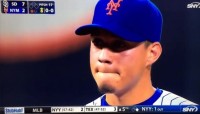
Going into the 2015 season, the Mets told everyone they were comfortable with Wilmer Flores as their shortstop. Going into this offseason, the Mets reminded everyone they made the World Series with Flores as their shortstop. As it turns out the Mets don’t regard Flores as anything more than a bench player.
With Daniel Murphy being a free agent, the Mets had the option to do the following with Flores: (1) leave him at shortstop or (2) move him to secondbase. The secondbase option became more viable when Ben Zobrist became a Cub. Instead the Mets traded for Neil Walker. After that, they signed Asdrubal Cabrera. In about a 34 hour timespan Flores went from starting middle infielder to a bench player.
Simply put, the Mets gave up on him. They gave up on a 25 year old baseball player they seemed to really like. They gave up on the idea that a hard worker like Flores would improve. Make no mistake, this has more to do with Flores’ bat than it has to do with his glove. It’s surprising because it was Flores’ bat that earned him the opportunity to play in the big leagues.
Simply put, while Flores showed some power, he was not very good at the plate. Last year, he hit .263/.295/.408. Walker hit .269/.328/.427. Cabrera hit .265/.315/.430. As an aside, Murphy hit .281/.322./.449. Seems important to mention since the Mets were making offensive and not defensive upgrades.
Last year, Flores had a UZR of 2.0 at secondbase and -2.5 at shortstop. Walker is coming off consecutive -6.8 UZR seasons at second. Here are Cabrera‘s UZRs at short since 2009: -5.0, -5.5, -11.0, -7.7, -12.8, -6.6, -6.0. Look at those numbers again. I know it’s hard for Mets fans to accept, but Flores is a better defender than Walker and Cabrera.
The reason it’s so hard is the early season troubles Flores had. He had trouble turning the double play. He had trouble making a play off his backhand. Here’s the thing. Remember the NLCS and World Series? Did either of those issues arise once? No. He was very solid at short, even if it was a limited sample size.
Ultimately, the Mets made these moves because of Flores’ offense, not his defense. They made these moves because they lost faith that Flores could ever improve enough to be an everyday player. Yes, they gave up on him being an everyday player. When you move a 25 year old to the bench, you’ve given up on him. You’ve given up on him when you bring in two weaker defenders in their 30s.
The Mets made these moves to improve their offense. It’s up for debate m as to whether it was the right move. What is not up for debate is the Mets giving up on Flores. It’s pretty clear that they did.
